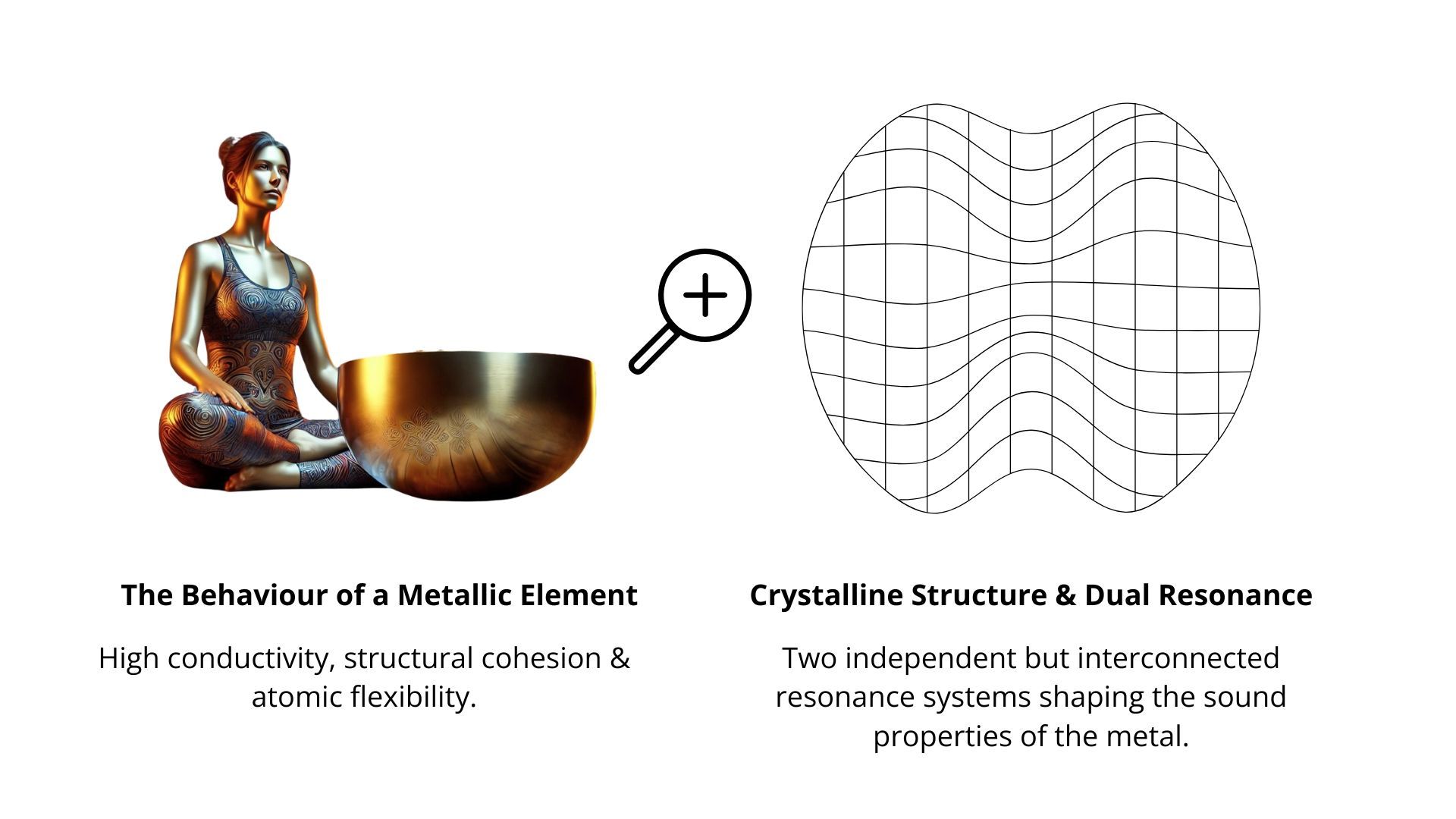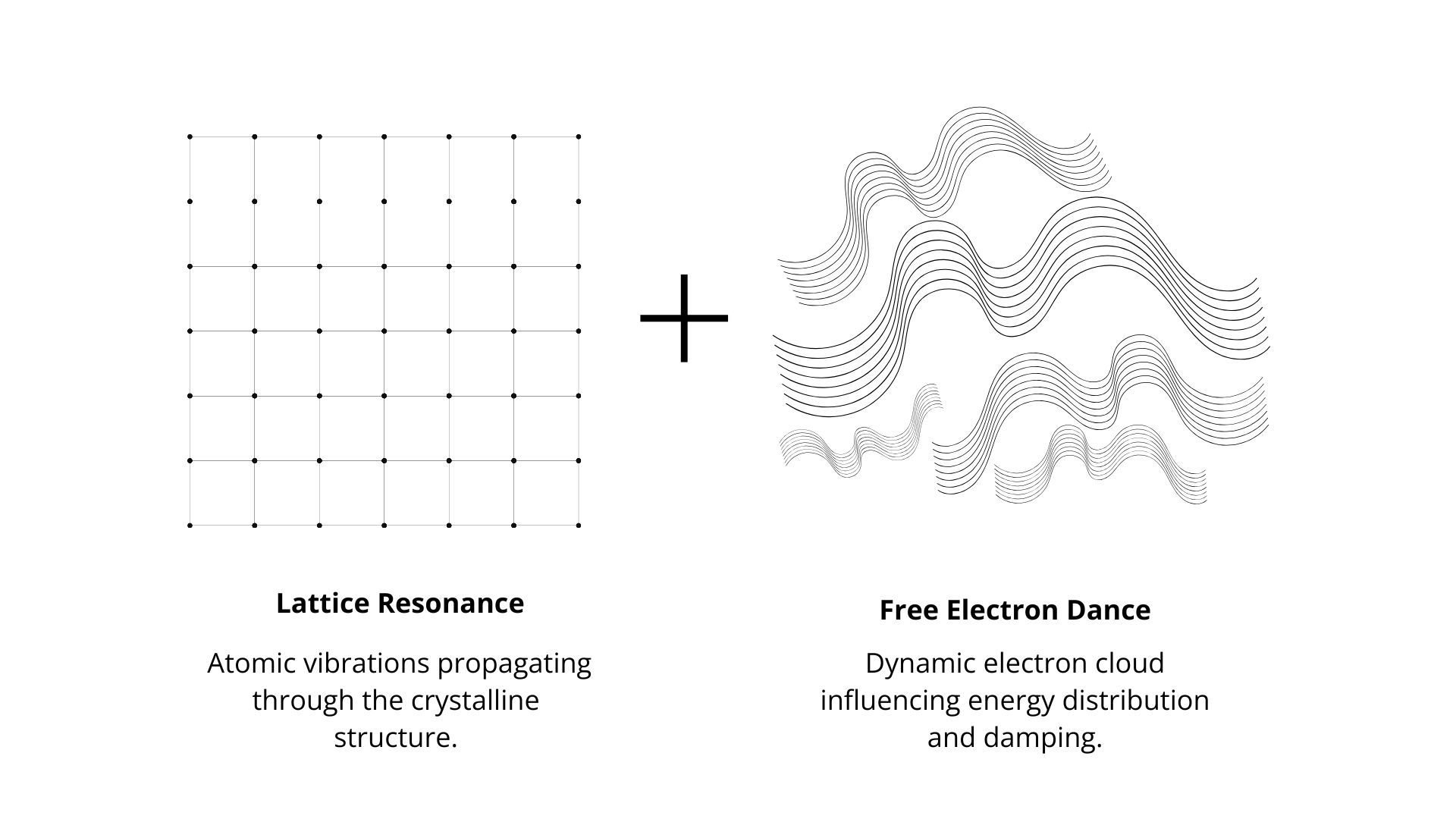Hidden Mantras: Metal, Alloy & the Sound of Singing Bowls
Metal transmits more than energy—it reveals the reality of vibration in a solid form.

In Sanskrit, the word mantra (मन्त्र) is derived from man (mind, thought) and tra (protection, tool), meaning "a tool of the mind" or "a formula that protects and liberates consciousness. More than mere recitation, mantras in Tantra are emitted, repeated, and resonated to generate specific effects on the being and its environment. From this perspective, every entity carries a unique vibrational imprint, one that is fluid yet intrinsic, shaping both identity and interaction with the world. This vibrational nature is not confined to living beings; it extends to materials, elements, and the very structure of matter itself.
In this paper, we explore the role of metal as an active medium in the study of sound behaviour, using the most naturally suited tool for this purpose, singing bowls, handcrafted from the sacred 7-metal alloy in Nepal. Through this, we examine how metal, as a structured yet dynamic element, participates in the transmission, sustain, and interaction of sound as a fundamental vibrational force.
What is an Alloy?
An alloy is a blend of multiple metals fused together to form a single material. Unlike what some might think, an alloy does not have separate layers, it is completely homogeneous. A good alloy for singing bowls will produce:
- A rich and stable sound: A well-crafted alloy creates a deeper, longer resonance with harmonics that naturally overlap.
- A balance between flexibility and rigidity: Some metals are too soft to vibrate cleanly, while others are too hard to resonate well. The right alloy achieves a perfect balance.
- Optimal transmission of vibrations: Metals conduct sound better than most other materials, allowing singing bowls to sustain their vibrations with exceptional clarity.

Why do metals resonate so well? The answer lies in their atomic structure.
- Unlike stone or wood, metal atoms are organised in a crystalline network, allowing sound waves to travel efficiently.
- Free electrons present in metals facilitate this transmission, acting like an energy current that amplifies vibration.
Two Independent Resonance Systems in Action
In a metallic crystalline network, two distinct but interconnected resonance systems coexist:
- Lattice Vibration (Atomic Resonance)
- The structured resonance of the metal occurs at the atomic level, where atoms oscillate within their fixed positions in the crystalline grid.
- This mechanical vibration propagates in a direct and orderly manner through the material, defining the metal’s acoustic properties.
- Electron Cloud Resonance (Free Electron Dynamics)
- The fluid resonance occurs within the free electron cloud, which is not fixed to the atomic lattice but moves dynamically throughout the metal.
- These electrons contribute to energy distribution and damping effects, subtly influencing how sound and vibration interact within the material.
While atomic resonance transmits mechanical waves, the electron resonance influences the material’s overall response to vibration, forming a dual system of interaction. This is why metal is a unique material for instrument-making: it extends sound beyond what the ear naturally expects, creating an immersive effect that combines pleasant sound & therapeutical vibrations on a cellular level.


When we think of metal, we imagine solid, shiny objects, but metals also exist in chemical form, invisible to the naked eye yet crucial to life.
Our cells contain small amounts of essential metals, which play key roles in bodily functions:
- Iron (Fe): Found in haemoglobin, transporting oxygen in the blood.
- Copper (Cu): Involved in energy production and tissue formation.
- Zinc (Zn): Essential for immunity and cellular regeneration.
- Magnesium (Mg): Critical for enzymatic reactions and muscle function.
These metals are not solid like those in a singing bowl, they exist in ionic form, meaning they are electrically charged atoms capable of interacting with other elements to regulate biological processes. This connection between metals and biology raises intriguing questions: can the vibrations of metal in a singing bowl influence the metals within our bodies?
What Alloy Structures Reveal About Sound and the Body
Understanding the internal structure of an alloy is not just a question of metallurgy, it has direct implications for sound transmission and interaction with the human body. Since alloys create specific atomic configurations, they influence the way vibrations are absorbed, reflected, and sustained.
In the case of singing bowls, the precise selection of metals in an alloy determines:
- Resonance and frequency range → The arrangement of atoms affects how sound waves propagate through the material, influencing the bowl’s ability to sustain vibrations over time.
- Tonal complexity → Alloys produce richer harmonic overtones compared to pure metals, making them ideal for meditation and sound therapy.
- Energy transfer to the body → Vibrations from the bowl travel through the air and the surface it touches, interacting with bodily tissues. Since the structure of the alloy governs these vibrational properties, it directly affects how sound is perceived and felt at a physiological level.
This understanding opens the door to scientific research on the effects of sound on the body, using alloys as a measurable reference point. By analysing the way different metal compositions affect vibration, researchers could:
- Study how specific alloys influence relaxation, brainwave activity, or physical healing processes.
- Develop new metallic instruments optimized for therapeutic effects, selecting alloys with precise vibrational properties.
- Establish data-driven frameworks for understanding the transmission of sound-based therapies, linking material science with physiology.
Rather than relying on anecdotal evidence, alloy-based analysis provides a stable and measurable foundation for research, offering clear data on how structured metals shape the interaction between sound and the human body.
The Stability of Metal and the Reliability of Singing Bowls
One of the key advantages of singing bowls lies in the stability of their material. Unlike organic materials, which degrade or change over time, metal alloys retain their structure and vibrational properties consistently. This makes them particularly reliable instruments for sound transmission, as their effects remain stable and repeatable.
This reliability is crucial when considering the interaction between sound and the human body. The resonance of a singing bowl is not just a passing auditory experience, it is a precise mechanical vibration that propagates through the air, water, and solid matter, including human tissue.
Research into vibrational medicine has already demonstrated that certain frequencies can influence biological processes, from brainwave synchronisation to cellular response mechanisms. The unique resonance of metal alloys in singing bowls suggests that their impact on the body is not arbitrary, but rather a structured vibrational interaction that could be studied and measured, much like any other therapeutic modality.
The use of metal-based sound instruments offers a stable and scientifically measurable foundation for sound therapy. While traditional medicine has long relied on chemical interactions, the structured resonance of alloys presents a mechanical and energetic approach that complements medical practices. The fact that metal naturally interacts with itself and with external vibrations as a constant indicates that singing bowls are not just instruments, but vibrational tools that engage with the body in a precise, beneficial way.
This positions singing bowls as more than cultural artefacts, they are instruments of resonance that offer a consistent and structured means of engaging with the body’s natural vibrational responses. Their metallic nature provides both durability and predictability, making them a trustworthy medium for sound-based therapeutic applications.
Thank you for taking the time to read, xx.












